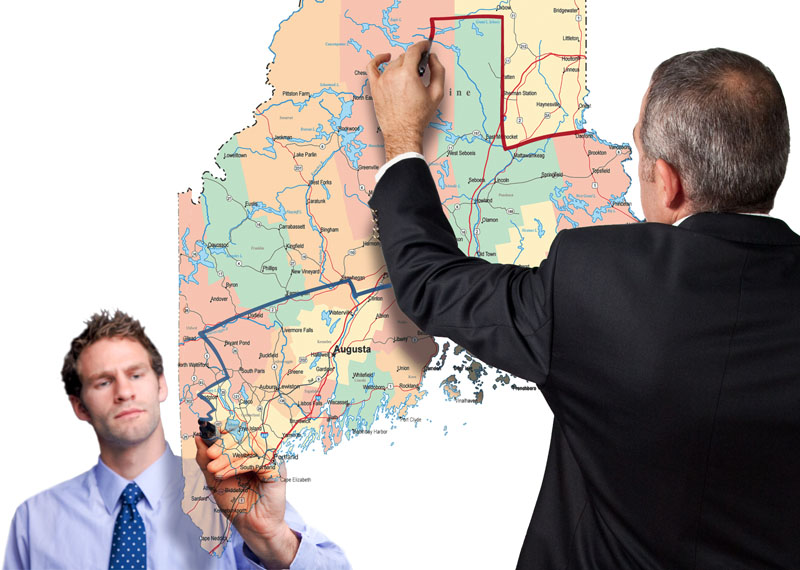NEW YORK – This month the Census Bureau will deliver reams of data, and states will begin to redraw legislative district lines. Brace yourself for a bacchanalia of self-dealing and partisan knife fighting, much of it conducted behind closed doors in state capitals.
Should past practice prevail, the result will be legislative maps that protect incumbents, sometimes squeezing minority voters in the process. Politics might grow even more polarized.
Citizens can try to pry open an often-secret process. And they can look for help not only from judges, but also from unlikely suspects: governors.
Gerrymandering is as old as the republic. In the very first election, none other than Patrick Henry drew district lines to try to keep James Madison from going to Congress. The term comes from an early Massachusetts governor, Elbridge Gerry, who drew a district shaped like a salamander. An editorial cartoon of the day dubbed the ungainly creature a “Gerrymander.”
In the early 1980s, legendary Democratic Congressman Phil Burton drew California’s plan sitting at Frank Fat’s Chinese restaurant in Sacramento.
According to Juliet Eilperin’s 2006 book “Fight Club Politics,” Burton used crude measures. Lots of Volvo registrations meant a yuppie Democratic district; lots of Buicks, a Republican one. In all, Democrats gained five seats. Burton wryly called the map “my contribution to modern art.”
As with so much else, the process has grown more sophisticated, soulless and corroding. Now, party leaders and fleets of consultants use computers and sophisticated software. They are able to slice districts with the precision of a sushi chef.
Usually, Democrats and Republicans crush each other if they can, squeezing out seats for their side. In 2003, Republican Tom DeLay, then the House majority leader, orchestrated a mid-decade gerrymander to help the Texas GOP. He is now prison-bound, having been found guilty of funding the move in part with illegal corporate funds. Still, it produced six new Republican congressmen.
Frequently, incumbents of both parties winkingly protect each other. New York University’s Samuel Issacharoff calls it a “political cartel.” In 2002, after that year’s redistricting, not a single California incumbent lost. Nationally more than 80 districts were essentially uncontested.
This time, the political field will likely tilt toward Republicans, because control shifted sharply in last fall’s election.
Twenty statehouses are now controlled entirely (governor and legislature) by the GOP. Democrats control 11. Many extra GOP seats may be baked into the Congress for a decade.
All this worsens hyper-partisanship. Political scientists note that when there is little competition between parties, challenges come from within parties. Like magnets, primary voters pull officials to the extremes. Compromise becomes ever more elusive.
If we don’t want the 2011 redistricting to make American politics even less responsive to actual communities, what can we do?
One answer is to take the power out of the hands of the elected politicians who stand to gain from the way the lines are drawn.
Already, Alaska, Arizona, Idaho and Montana give the pen to independent commissions. These can yield better balance.
Because of citizen referendums pressed by former Gov. Arnold Schwarzenegger, California now will use a panel as well. But it is too late for other states to go this way this time.
Citizens and journalists can play a role, too. Columbia University law professor Nathaniel Persily has enlisted his students to draw proposed maps, using widely available software.
Journalists can use state freedom of information laws to pry open doors of secrecy. Recognizable communities should insist on representation.
But ultimately, elected officials have the most power.
Let me suggest one group that might have more in mind than grubby partisan advantage. Governors must reach across party lines to achieve their goals. To govern, they must be seen as working above politics. And many of them look in the mirror and see a president when brushing their teeth.
Nobody wants to act nobly if it means helping the other side. But if governors of both parties say, together, “We won’t sign egregious gerrymanders,” nobody will feel the sucker. Governors can insist on reforms as the price for a signature.
A national blue-ribbon panel, suggested by hedge fund manager Jonathan Soros, might help chief executives of both parties give a thumbs up or down on their plans.
So Democratic Gov. Andrew Cuomo of New York, say howdy to Republican Rick Perry of Texas. Pat Quinn of Illinois, shake hands with Ohio Gov. John Kasich.
If you do, our politics might get a little less partisan, a little less dysfunctional, and a little more democratic. And the good deed would last a decade.
Michael Waldman, former head speechwriter for President Bill Clinton, is executive director of the Brennan Center for Justice at New York University School of Law and the author of “My Fellow Americans.”
Send questions/comments to the editors.



Success. Please wait for the page to reload. If the page does not reload within 5 seconds, please refresh the page.
Enter your email and password to access comments.
Hi, to comment on stories you must . This profile is in addition to your subscription and website login.
Already have a commenting profile? .
Invalid username/password.
Please check your email to confirm and complete your registration.
Only subscribers are eligible to post comments. Please subscribe or login first for digital access. Here’s why.
Use the form below to reset your password. When you've submitted your account email, we will send an email with a reset code.